Breech-loading swivel gun
A breech-loading swivel gun was a particular type of swivel gun and a small breech-loading cannon invented in the 14th century. It was equipped with a swivel for easy rotation and was loaded by inserting a mug-shaped device called a chamber or breech block, filled with gunpowder and projectiles. It had a high rate of fire, as several chambers could be prepared in advance and quickly fired in succession and was especially effective in anti-personnel roles. It was used for centuries by many countries of Europe, Asia and Africa.

Characteristics
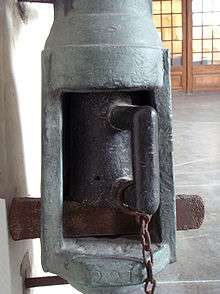
Although breech-loading is often considered a modern innovation which facilitated the loading of cannons,[1] breech-loading swivel guns were invented in the 14th century,[2] and used worldwide from the 16th century onward by numerous countries, many of them non-European. They have been called by many names, sometimes "Murderer" and "Base" in English,[3] "Pierrier à boîte" in French, "Berço" in Portuguese, "Verso" in Spanish,[4] "Kammerschlange" (lit. "chamber snake", properly means "breech-loading falconet") in German, "Folangji" or "Fo-lang-chi p'ao" ("佛朗机炮/佛朗機砲, Frankish gun") in Chinese,[5] "Bulang-kipo" ("불랑기포[佛郞機砲]") in Korean,[6] "Furanki" (仏郎機砲, "Frankish gun") or 子砲 ("Child cannon") in Japanese,[7][8] and "Bedil" or "bḍil" (ꦧꦣꦶꦭ) in Javanese.[9]:238 and 247 Some of them were used until the 20th century.[10]
Breech-loading swivel guns were developed surprisingly early, and were used from 1336 onward.[11] The guns were loaded with mug-shaped chambers, in which gunpowder and projectile had been filled in advance. The chamber was then put in place, blocked with a wedge, and then fired. As the loading was made in advance and separately, breech-loading swivel guns were quick-firing guns for their time.[12] An early description of a breech-loading swivel gun puts the weight of the gun at 118 kilograms (260 lb), equipped with three chambers for rotations, each 18 kilograms (40 lb) in weight, and firing a 280 grams (9.9 oz) lead shot.[13] The guns had a disadvantage: they leaked and lost power around the chambers, but this was compensated by the high rate of fire as multiple chambers could be prepared in advance.[14] Breech-loading swivel gun could fire either cannonballs against obstacles, or grapeshot against troops.[15]
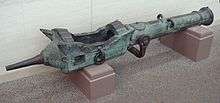
During the Middle-Ages, breech-loading swivel guns were developed by the Europeans also partly as a cheaper alternative to the very expensive bronze cast muzzle-loading cannons, as bronze was many times more expensive than iron. As cast iron was not yet technologically feasible for the Europeans, the only possibility was to use wrought iron bars hammered together and held with hoops like barrels. With this method, a one piece design was very difficult, and a fragmental structure, with separated chamber and barrel was then selected.[16][17]
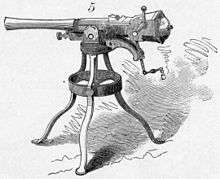
Around 1500, Europeans learnt how to cast iron, and shifted their cannon productions to one-piece iron muzzle-loaders. China started to adopt European breech-loading swivel guns from 1500 onward, limiting at the same time the production of their own muzzle-loaders, because of the high effectiveness of the breech-loading swivel gun as an anti-personnel gun, which to them was more interesting than the sheer power of a cannonball.[18]
Usage of the breech-loading swivel gun continued in Europe however, with, as early as the 17th century, characteristics very similar to the modern machine-gun or mitrailleuse.[19]
Use
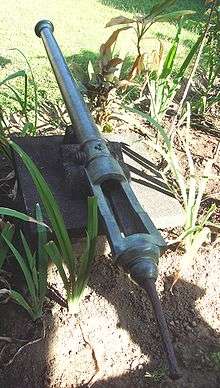

Breech-loading swivel guns were used to advantage at the bow and stern on warships, but were also used in fortifications.[20]
Breech loading cannons were used in Majapahit conquest (1336–1350).[21]:57 Prior to this, the Javanese acquired gunpowder technology from 1293 Mongol invasion.[22] The cannon is called Cetbang and can be configured as stationary gun or swivel gun, mounted on various vessels of Majapahit navy. At that time soldiers of other kingdoms in the Nusantara archipelago fought using melee weapons in an elevated platform in their ships called Balai, while also trying to board enemy vessels. Loaded with scattershot, the cetbang is very effective to counter this type of fighting.[23][24]
In China and Japan, breech-loading swivel guns were brought after China defeated the Portuguese in the 16th century. At the Battle of Xicaowan in 1522, after defeating the Portuguese in battle, the Chinese captured Portuguese breech-loading swivel guns and then reverse engineered them, calling them "Folangji" or "Fo-lang-chi"[5] (佛郎機 – Frankish) guns, since the Portuguese were called "Folangji" by the Chinese. A shipwreck in 1523 apparently brought the gun to China, but the transmission may have occurred earlier.[25][26] In Japan, Ōtomo Sōrin seems to have been the first recipient of the guns, possibly as early as 1551. In 1561 the Portuguese, allied with Otomo in the Siege of Moji, bombarded rival Japanese position, possibly with swivel guns.[1] In the Battle of Takajō in 1587, Ōtomo Sōrin used two swivel guns obtained from the Portuguese. The guns were nicknamed Kunikuzushi (国崩し, "Destroyer of Provinces").[27]
In the later portions of the Ming dynasty (mid 16th century onward) it appears that these type of guns were the most common and numerous type of artillery used by the Ming forces. a great deal of variation of such cannons were produced, and it appeared in pretty much all of the conflicts of this time, including the Imjin War. Until the introduction of heavy Dutch cannons in the early 17th century, there were even attempts by the Ming to make large heavy versions of such guns.
Other countries also used swivel guns. In Bali, such a gun was found in the possession of the Raja of Badung, and is now located in the Bali Museum. Numerous such guns were also used in Northern Africa by Algerian rebels in their resistance to French forces.[28]
Breech-loading swivel guns were also used extensively in Southeast Asia as early as the 16th century, apparently even before the arrival of the Portuguese and Spanish there, and continued to be in use as a preferred anti-personnel weapon as late as the 20th century. The Americans fought Moros equipped with breech-loading swivel guns in the Philippines in 1904.[23] In early 20th century, Chinese junks were armed with old-fashioned swivel guns, both muzzle-loader and breech-loader. The breech-loading guns were called "breech loading culverin" by Cardwell, they were 8 feet (2.4 m) long with 1–2 inches (2.54–5.08 cm) bore. These guns were fired using percussion cap mechanism.[29] Dyer c. 1930 noted the use of cannon by Makassan trepanger in Northern Australia, in particular the bronze breechloader with 2 inches (5.08 cm) bore.[30]
Steel rifled breech-loading swivel guns are known which were manufactured by the United States towards the end of the 19th century, and used in colonial theaters such as in Madagascar.[31]
Gallery
 Breech-loading swivel guns, 15-16th century. Swedish Army Museum.
Breech-loading swivel guns, 15-16th century. Swedish Army Museum.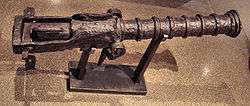 French breech-loading gun from 1410.
French breech-loading gun from 1410. Japanese breech-loading swivel gun. Caliber: 47 mm, length: 159 cm.
Japanese breech-loading swivel gun. Caliber: 47 mm, length: 159 cm. A 16th-century swivel breech-loading Japanese cannon, called an Ōzutsu (大筒, "Big tube").
A 16th-century swivel breech-loading Japanese cannon, called an Ōzutsu (大筒, "Big tube").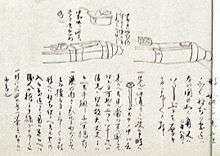 Description of the mechanism of a breech-loading swivel gun in Japanese. 16th century.
Description of the mechanism of a breech-loading swivel gun in Japanese. 16th century. Breech-loading swivel gun, Algeria, 1906. Caliber: 60 mm, length: 247 cm.
Breech-loading swivel gun, Algeria, 1906. Caliber: 60 mm, length: 247 cm.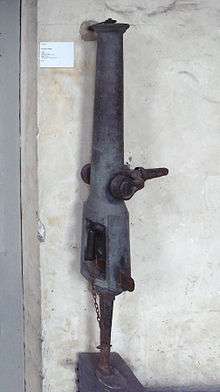 Breech-loading swivel gun, caliber: 72 mm, length: 140 cm, weight: 110 kg, seized by France in Constantine in 1837.
Breech-loading swivel gun, caliber: 72 mm, length: 140 cm, weight: 110 kg, seized by France in Constantine in 1837. Korean breech-loading swivel gun with mug-shaped chamber
Korean breech-loading swivel gun with mug-shaped chamber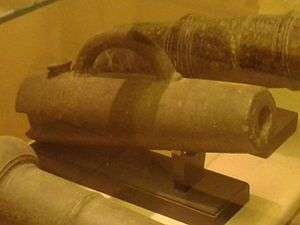 17th century Vietnamese breech block.
17th century Vietnamese breech block. A double barrelled cetbang on a carriage, with swivel yoke, ca. 1522. The mouth of the cannon is in the shape of Javanese Nāga.
A double barrelled cetbang on a carriage, with swivel yoke, ca. 1522. The mouth of the cannon is in the shape of Javanese Nāga.
See also
Notes
- Turnbull, p. 105
- Samurai - The World of the Warrior Stephen Turnbull p. 105
- Alexzandra Hildred (2009). Peter Marsden (ed.). Your Noblest Shippe: Anatomy of a Tudor Warship. The Archaeology of the Mary Rose, Volume 2. The Mary Rose Trust, Portsmouth. pp. 297–344. ISBN 978-0-9544029-2-1.
- Spanish Galleon 1530-1690 by Angus Konstam p.15
- Charney, Michael (2004). Southeast Asian Warfare, 1300-1900. BRILL. ISBN 9789047406921.
- ko:불랑기포
- Samurai - The World of the Warrior Stephen Turnbull p. 106
- Musée de l'Armée, Paris.
- Manguin, Pierre-Yves (1976). "L'Artillerie legere nousantarienne: A propos de six canons conserves dans des collections portugaises". Arts Asiatiques. 32: 233–268.
- Musée de l'Armée, Paris.
- Dr. J.L.A. Brandes, T.B.G., LII (1910)
- Perrin, p. 29
- Turnbull p. 106
- Turnbull p. 105-106
- Firearms: a global history to 1700 by Kenneth Warren Chase p.143
- Firearms: a global history to 1700 by Kenneth Warren Chase p.143
- Tudor Warships (1): Henry VIII's Navy Angus Konstam p.34
- Firearms: a global history to 1700 by Kenneth Warren Chase p.143
- HISTORY AND DESCRIPTIVE GUIDE OF THE U.S. NAVY YARD, WASHINGTON COMPILED BY F. E. Farnham and J. Mundell. WASHINGTON, D.C.: GIBSON BROS, PRINTERS AND BOOKBINDERS. 1894 p.19
- Perrin, p. 29
- Pramono, Djoko (2005). Budaya Bahari. Gramedia Pustaka Utama. ISBN 9789792213768.
- Song Lian. History of Yuan.
- Ooi, Keat Gin (2004). Southeast Asia: A Historical Encyclopedia, from Angkor Wat to East Timor. ABC-CLIO. ISBN 9781576077702.
- Reid, Anthony (2012). Anthony Reid and the Study of the Southeast Asian Past. Institute of Southeast Asian Studies. ISBN 978-981-4311-96-0.
- Turnbull p. 106
- DK (2 October 2006). Weapon: A Visual History of Arms and Armor. DK Publishing. pp. 100–. ISBN 978-0-7566-4219-8.
- Turnbull p. 106
- Musée de l'Armée, Paris.
- Garrett, Richard J. (2010-03-01). The Defences of Macau: Forts, Ships and Weapons over 450 years. Hong Kong University Press. ISBN 978-988-8028-49-8.
- Dyer, A. J. (1930). Unarmed Combat: An Australian Missionary Adventure. Edgar Bragg & Sons Pty. Ltd., printers 4-6 Baker Street Sydney.
- Musée de l'Armée exhibit
References
- Perrin, Noel 1979 Giving up the Gun, Japan's reversion to the Sword, 1543-1879 David R. Godine, Boston ISBN 0-87923-773-2